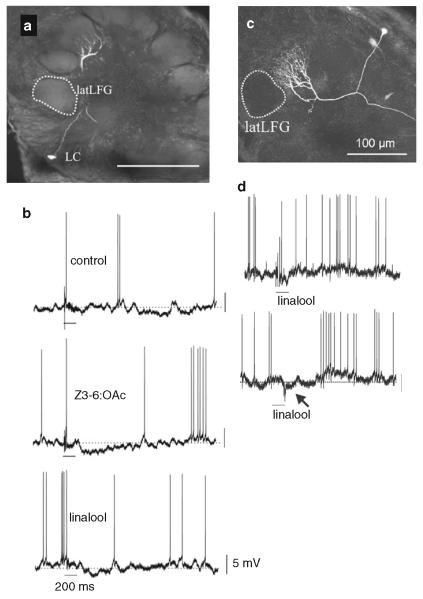Fig. 9.
Odorant responses of projection neurons in the antennal lobe of female Manduca. a Morphology of a projection neuron with arborizations restricted to a glomerulus near the lateral Large Female Glomerulus, latLFG (dotted area) and G35 (not visible in this section; image obtained after sectioning), i.e., this PN is arborizing in a sexually isomorphic glomeruli of the female antennal lobe near latLFG and G35. The cell body is located in the lateral group of neuronal cell bodies (LC). Scale bar 200 μm. b Electrophysiological responses of this PN to stimulation with the mineral oil control, Z3-6:OAc, and [±]linalool. The odorants linalool and Z3-6:OAc strongly stimulate PNs in the latLFG and G35, respectively, and to a less extent, PNs in other glomeruli (Reisenman et al. 2004, 2005; Roche King et al. 2000). Note that both Z3-6:OAc and [±]linalool elicited hyperpolarization in this PN (deflections below the resting potential, dotted area). c Morphology of a projection neuron arborizing in the medial Large Female Glomerulus, medLFG. d Physiological responses obtained from the PN in c to a control stimulus and stimulation (duration 200 ms) with (±)-linalool, the stimulus that preferentially activates latLFG-PNs. Note that stimulation with linalool evokes an inhibitory response (membrane potential hyperpolarization) suggesting that the two large female glomeruli interact with each other similarly to the two main glomeruli of the MGC. Calibration bars 5 mV, 200 ms in all panels (b, d). Modified from Reisenman et al. (2008)

